Intro
Discover foods high in fiber, including fruits, vegetables, and whole grains, to boost digestive health and support healthy blood sugar levels with soluble and insoluble fiber rich foods.
A diet rich in fiber is essential for maintaining a healthy digestive system, promoting satiety, and supporting healthy blood sugar levels. Foods high in fiber are also often rich in essential vitamins, minerals, and antioxidants, making them a great addition to a balanced diet. With the numerous benefits of fiber, it's no wonder that health experts recommend consuming a significant amount of fiber-rich foods daily. In this article, we will delve into the world of high-fiber foods, exploring their benefits, types, and ways to incorporate them into your daily meals.
Fiber is a type of carbohydrate that is not easily broken down by the body, making it an excellent tool for promoting digestive health. A high-fiber diet can help prevent constipation, diverticulitis, and even certain types of cancer. Moreover, fiber-rich foods tend to be more filling, making them an excellent choice for those trying to manage their weight. With the rise of processed and low-fiber foods, it's more important than ever to focus on whole, nutrient-dense foods that provide the body with the fiber it needs to function optimally.
The benefits of a high-fiber diet are numerous, and it's essential to understand the different types of fiber and how they can be incorporated into your daily meals. Soluble fiber, found in foods like oats, barley, and fruits, can help lower cholesterol levels and regulate blood sugar levels. Insoluble fiber, found in foods like whole wheat, vegetables, and nuts, can help promote digestive health and prevent constipation. By consuming a variety of high-fiber foods, you can reap the rewards of a healthy digestive system, improved satiety, and a reduced risk of chronic diseases.
Fiber-Rich Fruits
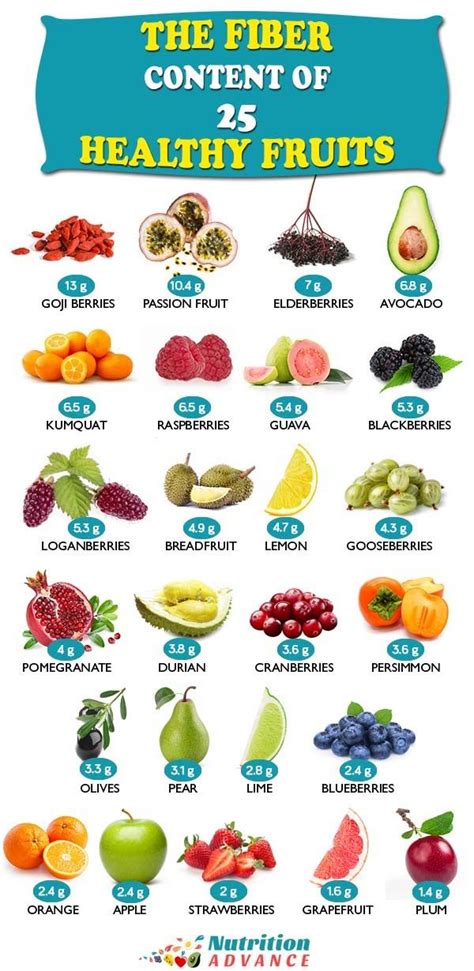
Top 5 High-Fiber Fruits
Here are the top 5 high-fiber fruits to add to your diet: * Avocado (1 medium: 10 grams of fiber) * Guava (1 cup: 9 grams of fiber) * Pear (1 medium: 6 grams of fiber) * Apple (1 medium: 4 grams of fiber) * Banana (1 medium: 3 grams of fiber)Fiber-Rich Vegetables
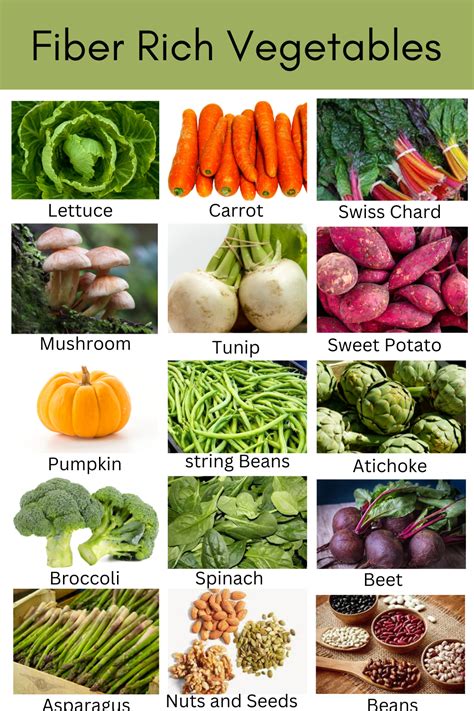
Top 5 High-Fiber Vegetables
Here are the top 5 high-fiber vegetables to add to your diet: * Artichoke (1 medium: 10 grams of fiber) * Peas (1 cup: 9 grams of fiber) * Broccoli (1 cup: 5 grams of fiber) * Carrots (1 cup: 3 grams of fiber) * Brussels sprouts (1 cup: 5 grams of fiber)Fiber-Rich Grains
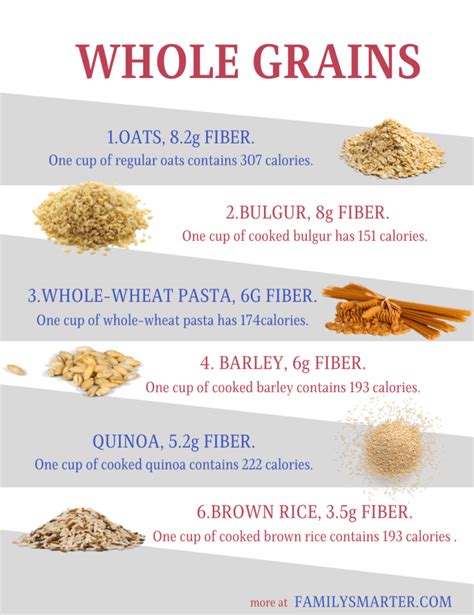
Top 5 High-Fiber Grains
Here are the top 5 high-fiber grains to add to your diet: * Whole wheat (1 slice: 3 grams of fiber) * Quinoa (1 cup: 5 grams of fiber) * Brown rice (1 cup: 3 grams of fiber) * Oats (1 cup: 4 grams of fiber) * Barley (1 cup: 6 grams of fiber)Fiber-Rich Legumes
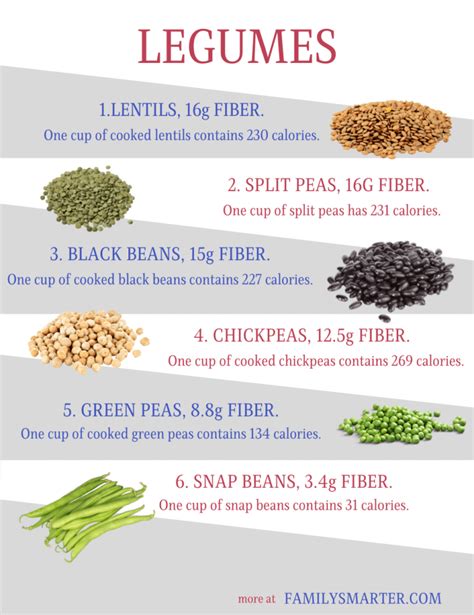
Top 5 High-Fiber Legumes
Here are the top 5 high-fiber legumes to add to your diet: * Lentils (1 cup: 16 grams of fiber) * Chickpeas (1 cup: 12 grams of fiber) * Black beans (1 cup: 9 grams of fiber) * Kidney beans (1 cup: 8 grams of fiber) * Pinto beans (1 cup: 9 grams of fiber)Fiber-Rich Nuts and Seeds
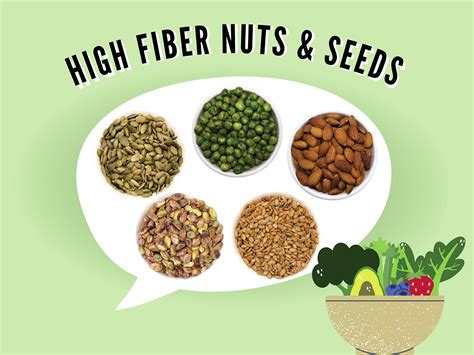
Top 5 High-Fiber Nuts and Seeds
Here are the top 5 high-fiber nuts and seeds to add to your diet: * Chia seeds (1 tablespoon: 5 grams of fiber) * Flaxseeds (1 tablespoon: 3 grams of fiber) * Almonds (1 ounce: 3 grams of fiber) * Pumpkin seeds (1 ounce: 2 grams of fiber) * Sunflower seeds (1 ounce: 3 grams of fiber)Incorporating Fiber-Rich Foods into Your Diet
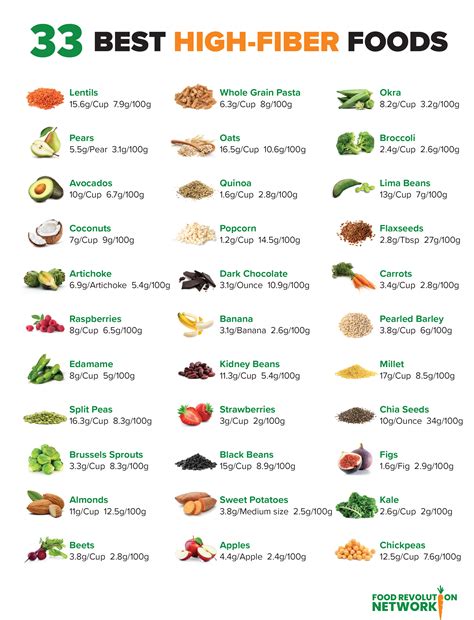
Tips for Increasing Fiber Intake
Here are some tips for increasing your fiber intake: * Start your day with a high-fiber breakfast, such as oatmeal with fruit and nuts * Snack on high-fiber fruits and vegetables, such as apples and carrots * Incorporate legumes into your meals, such as lentils and chickpeas * Choose whole grains over refined grains, such as brown rice and whole wheat bread * Add nuts and seeds to your meals, such as almonds and chia seedsWhat are the benefits of a high-fiber diet?
+A high-fiber diet can help promote digestive health, support healthy blood sugar levels, and even reduce the risk of certain diseases, such as heart disease and diabetes.
How much fiber should I consume per day?
+The daily recommended intake of fiber is 25-30 grams per day, although some experts recommend consuming even more fiber for optimal health benefits.
Can I get too much fiber in my diet?
+Yes, it is possible to consume too much fiber, which can lead to digestive issues such as bloating, gas, and stomach cramps. It's essential to increase fiber intake gradually and listen to your body's response.
Are there any foods that are high in fiber but low in calories?
+Yes, there are many high-fiber foods that are low in calories, such as fruits, vegetables, and legumes. These foods are not only rich in fiber but also provide essential vitamins, minerals, and antioxidants.
Can I take fiber supplements if I'm not getting enough fiber from my diet?
+While fiber supplements can be helpful, it's always best to get fiber from whole foods whenever possible. Fiber supplements can be beneficial for those who have trouble consuming enough fiber from whole foods, but it's essential to consult with a healthcare professional before starting any supplement regimen.
In conclusion, incorporating fiber-rich foods into your diet can have numerous health benefits, from promoting digestive health to supporting healthy blood sugar levels. By understanding the different types of fiber and how to incorporate them into your daily meals, you can reap the rewards of a high-fiber diet. Remember to start slowly, listen to your body's response, and aim to consume at least 25-30 grams of fiber per day. With the numerous benefits of fiber and the variety of high-fiber foods available, there's no reason not to make fiber a priority in your diet. We encourage you to share your favorite high-fiber recipes, ask questions, and join the conversation about the importance of fiber in our diets.
